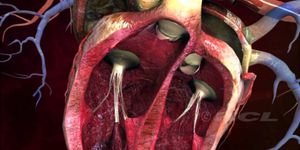Genetics & Genomics
New Technique of Studying Insect Physiology Through DNA Extractions
FEB 17, 2014 12:00 AM PST
Share
Glowing Plants, Healthy Plants
 If we mention glowing plants, do you think of Homer Simpson pushing the wrong button at the Springfield Nuclear Plant? Or perhaps you think of something from a bad science fiction movie that slowly creeps down the street, occasionally pausing to devour bad actors?
If we mention glowing plants, do you think of Homer Simpson pushing the wrong button at the Springfield Nuclear Plant? Or perhaps you think of something from a bad science fiction movie that slowly creeps down the street, occasionally pausing to devour bad actors? As it turns out, healthy plants really do give off a glow, although it is faint and difficult for humans to see - it emits at the far end of the red wavelength range, toward near-infrared. The glow is a byproduct of the photosynthesis process after a plant's chlorophyll has absorbed and processed sunlight. In relative terms, the presence of the glow represents the efficiency of its photosynthesis, and therefore a measure of its overall health.
It's been proposed that the ability to produce plant fluorescence maps on the broad scale could provide insight into the relative health of ecosystems. Information could be derived on such things as the movement of carbon between the atmosphere and the plant population, relative effects of the water cycle, efficient use of fertilizers, and many other topics that could be used to improve both agricultural productivity and conservation efforts. Measuring such a faint glow in a convenient airborne method has been a challenge, but a European group has demonstrated enough progress that the ESA (European Space Agency) is considering launching a new satellite to implement this technology.
The proposed Fluorescence Explorer (FLEX) satellite would measure plant fluorescence using technology developed at the Forschungszentrum Jülich Research Center in Germany and prototyped by the Specim company in Finland. This team created the Hyplant airborne sensor, which has made over 100 trips on aircraft, and has returned enough data to produce consistent and useful fluorescence maps.
The faint glow is picked up by two imaging spectrometers that provide complementary data, with one spectrometer handling the broader background wavelengths from blue to the mid-infrared range (effectively covering the visible light range plus part of the infrared), and a second spectrometer with very fine wavelength gradations focused on the red to near-infrared range of plant fluorescence.
As an example of the utility of the maps, a map produced in October shows the highest degree of fluorescence in sugar beet plants, a biannual crop that happens to be one of the most active plants at that time of year (with respect to photosynthesis). By contrast, other plants such as pine trees and apple orchards showed a lower level of fluorescence - and as expected, roads, buildings and dirt did not fluoresce at all.
With a tool like this aboard a satellite, it would be possible to get constant information on the photosynthetic activity of any area and assess the continued health of the area's plant life, as well as any unusual changes in the pattern. Theoretically this tool would also open the door for new farming techniques and breeding programs. A workshop on these developments is scheduled for April 22nd-24th in Paris, to be hosted by France's CNES space agency.
So plants are glowing all around you, whether you realize it or not - but if you can see the glow without the Hyplant sensor or the FLEX satellite, perhaps you should look out for Homer Simpson.
Image: U. Rascher, Forschungszentrum Jülich
You May Also Like
Loading Comments...








